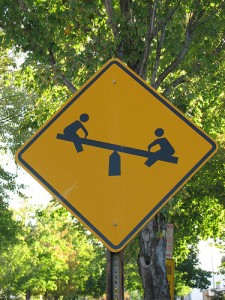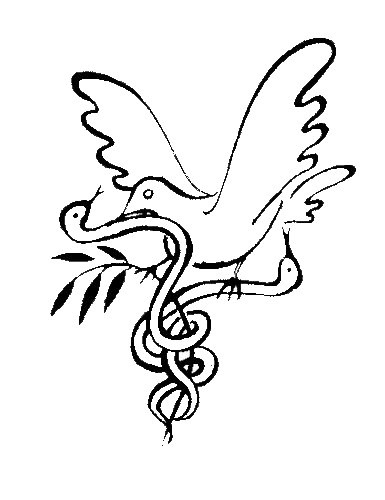May 11, 2010
The Case of the Missing See-Saws
 [ed: They past few months I was commissioned to explore a series of rabbit/fox/worm holes, collecting inter-dimensional tales along the way. Now that I have returned home, some typing is long overdue].
[ed: They past few months I was commissioned to explore a series of rabbit/fox/worm holes, collecting inter-dimensional tales along the way. Now that I have returned home, some typing is long overdue].
A few months ago I started wonder when and why children’s playgrounds have became so darn safe. Its no secret that litigation (both the fear and the reality) has slowly been transforming playgrounds into rubber rooms for decades.
In his analysis of Junk Playgrounds, Roy Koslovsky has advanced the argument that the activities children are immersed in are models of the kinds of citizens we want them to become. (see Adventure Playground and Postwar Reconstructions in Designing Modern Childhoods). What might children learn from (supervised) danger and what are they missing when we they are excessively insulated and protected?
Without exposure to some risk, how are children supposed to learn to evaluate and take chances, the consequences of their actions, and the Golden Rule – what goes around comes around? If we don’t provide them with the space to develop and exert their agency and will, are these lessons lost? Can they be adequately taught through simulation?
Against this backdrop, I followed up a lead from a reliable informant (my Dad) and began visiting local playgrounds. I first ventured out on a snow day back in February. The playgrounds were appropriately locked down that day, since apparently the last place we want kids playing in the snow is under controlled supervision. But children weren’t the only thing missing form the playgrounds… I also noticed something else – or, more accurately – didn’t notice something else. I visited half a dozen playgounds and I didn’t see a single See-Saw!
Since then I have been informally asking around and I am pretty sure the last public see saw on the island of Manhattan is in a park on 84th and Riverside. There are still a few See-Saws left in the South Bronx and the suburbs, but in NYC they are an endangered species.
This got me wondering – What do children learn from See-Saws? Without conducting any formal research, but after a few good conversations, I hypothesized this answer – On the physical plane: balance, gravity, and equilibrium. On the social plane: cooperation, friendship and trust. Heck, the see-saw is the only activity in the playground where kids are necessarily looking each other in the eyes. If you betray someone on the see saw, playground rules. You will learn that what goes around comes around even without the merry go round (those disappeared before my time – now that toy was dangerous). And if you don’t eventually learn your lesson on the See-Saw, you might find yourself without friends within a few years.
What kinds of effects might we expect from restricting children to hamster tubes which overlooking simulated danger? Perhaps none. Or, perhaps these attitudes are contributing to the fear, anxiety, restlessness and behavioral disorders being reported and diagnosed in children at alarming rates.
They came first for the merry go rounds, then they came for the see saws, soon they’ll come for the swings! If only we could figure out who the capital ‘T’ They are….
 Filed by jonah at 12:09 am under earth,ethics
Filed by jonah at 12:09 am under earth,ethics
 5 Comments
5 Comments


I wonder how many kids are actually injured at official playgrounds. Perhaps this is my heritage as someone not from the city, but I didn’t spend much time in parks or playgrounds as a kid. I spent a lot of time in (much larger) school yards than exist here, and a lot of time in the woods.
As such, the sanitization of schoolyards isn’t something that I find meaningful. Most of the damage inflicted upon me as a youngster was due to some “mock” violence I was participating in. Many of our schoolyard games involved fighting or scaring each other. It wasn’t malicious, but it was terribly violent (… and fun).
I think when it comes down to it, kids can be pretty nasty (even when it’s all in good fun). Removing the see saw doesn’t remove the kids’ (from my experience) unrelenting appetite for violence, chaos, and competition to see who has the least fear. I almost see the games in the play ground as distractions from the terrible things kids would be doing without them. The see saw and the merry go rounds are really only dangerous when misused (see: p.s. http://www.youtube.com/watch?v=iRasoZMirRc). Without those, there will always be the age old “get as far from the ground as you possibly can and jump” or the classic, “fight and grapple until someone stops having fun, perhaps because they’ve been seriously injured”.
What could be more fitting than the name “see saw” for something, now in the past tense, that, to use, one has to first see another? The “see saw” describes itself! It is something one must see that we only rarely can say we saw. (To your tally, I last saw a see-saw near the Columbia river gorge between Washington and Oregon.) Very much in favor of arguments, like yours, that challenge zero-sum assumptions about the relationship between risk and security. Of course, see-saws allow for betrayal (drop the other guy off) as well as cooperation, which is probably part of the larger creative risk part of play your argument supports.
Have you ever seen flying foxes? http://www.adventurelogue.com/destinations/flying-fox-ride-in-new-zealand.html
They have playground versions of these all over the country in new zealand. Other than being freaking awesome, and suitable for adults to play on as well, I thought to myself – what has gone so wrong in america that we don’t have fun like this anymore?
Anyway, if there was a message for me, it was: I want to live with these crazy people that teach their children to play unsupervised on dangerous ziplines in a country that is largely a tropical paradise.
Not really what you were talking about, but I liked your thought.
Gever Tulley has a couple of very good videos at ted.com on the issue of teaching children to learn about the world that are relevant to your inquiry: Gever Tulley teaches life lessons through tinkering and Gever Tulley on 5 dangerous things for kids.
In the Midwest playgrounds not only have see saws (which we call teeter totters) but merry go rounds and flying foxes, too! Also farms. The divergence between urban and rural culture grows…